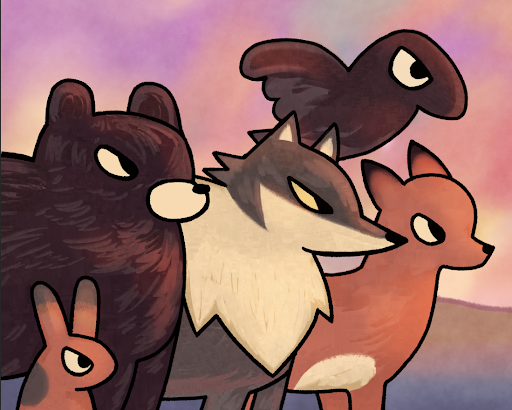Overview
Why Animals Have Black on Their Fur: A Paiute Creation Story

Authors:
Chris LaMarr (Paiute, Pit River, and Maidu - member of the Susanville Indian Rancheria) Educator and co-founder of WithOut Rezervation Collective
Gordon LaMarr (Northern Paiute - member of the Fort McDermitt Indian Nation) Honored Elder, Storyteller and Paiute Linguist
Zion LaMarr (Paiute, Pit River, and Modoc - member of the Susanville Indian Rancheria), Artist and Illustrator
Anaya EchoHawk-Flint (Pawnee, Yakama, Paiute, and Pit River), Digital Project Director WithOut Rezervation Collective
Language integration, lesson edit and format by Maggie Peters (Yurok/Karuk), NASMC Learning Specialist, Humboldt County Office of Education
Grades: TK-2
Suggested Amount of Time: Two 45 minute sessions (can break into three sessions of 30 minutes)
Curriculum Themes:
- History
- Cultural Strengths
- Relationship to Place
- Cross Curricular Integration
Learning Goals
- Listen to and describe details of the Paiute creation story, "Why Animals Have Black on Their Fur" in their own words, showing understanding of the main events and characters.
- Identify and name animals from the story using their names in Paiute language.
- Recognize the cultural importance of storytelling in Paiute traditions and how stories help explain the natural world and reflect the connection of land to Indigenous peoples.
- Practice tracing and writing to develop fine motor skills, proper pencil grip, and correct letter formation.
- Create a simple art piece or drawing of one animal from the story, including its Paiute name and showing where the black marks appear.
Lesson Overview
In this lesson, students in TK-2 will explore the Paiute origin story “Why Animals Have Black on Their Fur” to build understanding of Native storytelling, language, and culture. The lesson begins by introducing the Paiute people as one of the first groups to live in the regions we now call Nevada, California, Oregon, and Idaho. Students will learn that the Paiute people have their own language and that they have rich traditions, including storytelling, that help explain the natural world and show the deep connection between people and the land. Teachers will guide students in understanding that while many Native peoples faced hardship through colonization, the Paiute people are thriving today, actively preserving their language, tenuring lands, and revitalizing culture.
After this cultural introduction, students will listen to the origin story and describe what happens, including who the characters are—especially animals and celestial beings—and how the animals got the black marks on their fur. As part of this language-integrated lesson, students will learn and practice Paiute words for some of the animals and beings mentioned in the story. Teachers will use visuals, modeling, and interactive slides with audio buttons so students can hear and repeat the Paiute words. This practice supports both oral language development and cultural appreciation.
To deepen their engagement, students will complete two hands-on activities. First, they will use a color-and-say worksheet where they color the animals from the story and practice saying their Paiute names. Second, they will trace and write the Paiute words on a writing practice page, helping to develop fine motor skills and letter formation. These activities will allow students to connect storytelling with language learning in a joyful and age-appropriate way. The lesson may conclude with a drawing activity, a group reflection, or a short review of what students learned about the Paiute people and their traditions.
Teacher Background
Like many Indigenous languages, Paiute has been deeply affected by centuries of colonization, forced relocation, and cultural suppression. Once widely spoken across areas of Nevada, California, Oregon, and Idaho, the language now has only around 700 speakers. Despite this, Paiute communities are actively working to revitalize and preserve their language, recognizing it as a vital part of their identity, worldview, and connection to land and culture. As educators, we have a meaningful opportunity to support these efforts by introducing students to Paiute language and storytelling in joyful, respectful, and age-appropriate ways.
This lesson invites students to engage with a Paiute creation story, explore the Paiute people's connection to nature and animals, and learn animal names and celestial beings in the Paiute language. In doing so, students are gaining a deeper understanding of Native culture, resilience, and ways of knowing. Every Paiute word spoken in the classroom contributes to a broader movement to honor, protect, and uplift Indigenous voices.
Storytelling holds deep cultural and educational value in Paiute communities. It is a way of teaching children about the natural world and a tool for passing on history, values, and language across generations. By including Paiute words in classroom stories through interactive google slides featuring audio buttons as well as writing practice, students build early literacy while also developing cultural awareness, empathy, and respect for Native peoples.
While it’s important to acknowledge the harmful effects of colonization, including the displacement and loss experienced by Native communities, it is equally vital to teach children that the Paiute are beautiful, resilient people. They are living, thriving, and reclaiming what was taken from them. This lesson supports that truth by offering students a lens into living Indigenous culture, through storytelling and language. It fosters connection and appreciation between Native and non-Native students alike.
By implementing this lesson, educators become part of a larger commitment to truth-telling, respect, and the celebration of Indigenous language, land, and life– helping to ensure the stories, languages, and traditions of the Paiute people continue to be heard, spoken, and honored for generations to come. There are a few Yurok stories offered at the end to extend the storytelling experience.

